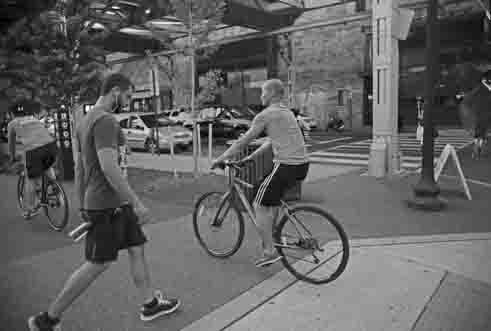ANC Seeks Help on Bike Traffic Issues

By Kat LuceroCurrent Staff Writer
Below the Whitehurst Freeway, a one-mile stretch of road has become increasingly popular for cyclists. Although there are no designated bike lanes on the connecting Water and K streets, commuters use them to connect to two bike trails — the Capital Crescent to the west and Rock Creek Park’s path to the east.
“It’s a chaotic environment,” said Georgetown advisory neighborhood commissioner Bill Starrels, who represents the area in Georgetown.
The Georgetown neighborhood commission is urging the city to examine and improve the area’s safety. In a June 5 letter to transportation director Matthew Brown, the commission specifically asks the agency to determine ways to calm the bike traffic, including possibly by installing raised crosswalks.
Traffic on the stretch is most concentrated during the weekday morning and evening rush hours, mostly from commuters living in Maryland and westernmost D.C.
The Capital Crescent Trail is one of the most heavily used “multiuse trails not only in the region, but in the entire country,” attracting millions of users each year, according to Gregory Billing of the Washington Area Bicyclist Association.
The heavy flow of bike traffic then goes into Georgetown’s Water Street. Problems arise when cyclists ignore the “rules of the road,” Starrels said. He said a growing number of fast-riding cyclists pose safety concerns for pedestrians and drivers, whose numbers have also increased.
“It’s gotten to the point where it’s necessary to get a dialogue going” with the D.C. Department of Transportation, Starrels said.
Ward 2 D.C. Council member Jack Evans said he has also heard complaints about cyclists — and even seen them zooming through this corridor.
“I jog every day. I can’t tell you the number of times bikes just fly through there. … I’ve seen people almost get hit,” he said.
Asked why there hasn’t been action to solve this traffic issue, Evans said, “Nobody knows what to do.”
Two ideas he’s heard — installing speed bumps on the street and requiring license plates for bikes — didn’t prove popular, Evans said. And while he doesn’t have an effective fix, he said the issue does raise the bigger question of how to get the cyclists to obey the law.
“It’s a problem all over the city,” he said.
Districtwide, the number of cyclists on the streets has quadrupled since 2006, according to Billings. He attributed the problems beneath the Whitehurst to overstressed infrastructure.
“The street is not designed to carry all that bike traffic,” he said.
The D.C. Department of Transportation’s Sam Zimbabwe said yesterday that this area is “not one of our high crash locations,” but he acknowledged that there are issues to address.
Zimbabwe also conceded that there’s no easy solution, with all the cyclists there converging to head to “various locations downtown.”
Of the high speeds on bikes, he noted that the area is one where cyclists adjust from riding down a “high-quality trail” devoid of stop signs to a “free-for-all” in a commercial section of Georgetown.
“The selected route for the streetcar also adds to the complexity,” said Zimbabwe, referring to the city’s long-range plans for the corridor. He said detailed planning for the streetcar, including an environmental assessment, will give the agency an in-depth look at the area’s transportation issues, including bike safety.
Many avid cyclists say a designated bike lane is part of the solution.
Billing recommends “a protected lane or dedicated bike space, especially for that eastbound traffic to get it out of the flow from all the other traffic out there.”
Georgetown commissioner Tom Birch, who cycles frequently, also supports a dedicated bike lane along that street.
Marco Dicapua, a cycling commuter living on the 1000 block of 30th Street, would like to see a bike lane and maybe increased signage; but he “personally doesn’t see any good solutions for K Street” between 27th and 34th streets. He noted the commercial strip’s disjointed connections, as well as the presence of several driveways that pose an additional safety concern.
Dicapua, however, said he “feels quite safe” biking through the wider K Street in comparison to the busier, narrower M Street. “The street is wide enough where there’s enough room for cars and cyclists if we all share the road,” he said, adding that he hasn’t seen accidents involving bikes.
Zimbabwe of the Transportation Department noted that installing bike lanes there would create other transportation consequences, such as eliminating parking spaces.
While neighborhood commissioner Starrels acknowledges that a solution won’t happen right away, he said the point of the resolution he authored is to “to wrap up this problem.”
This article appears in the June 25 issue of The Georgetown Current newspaper.
